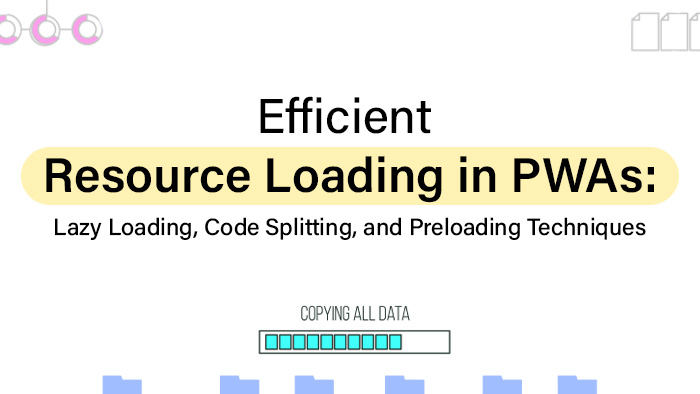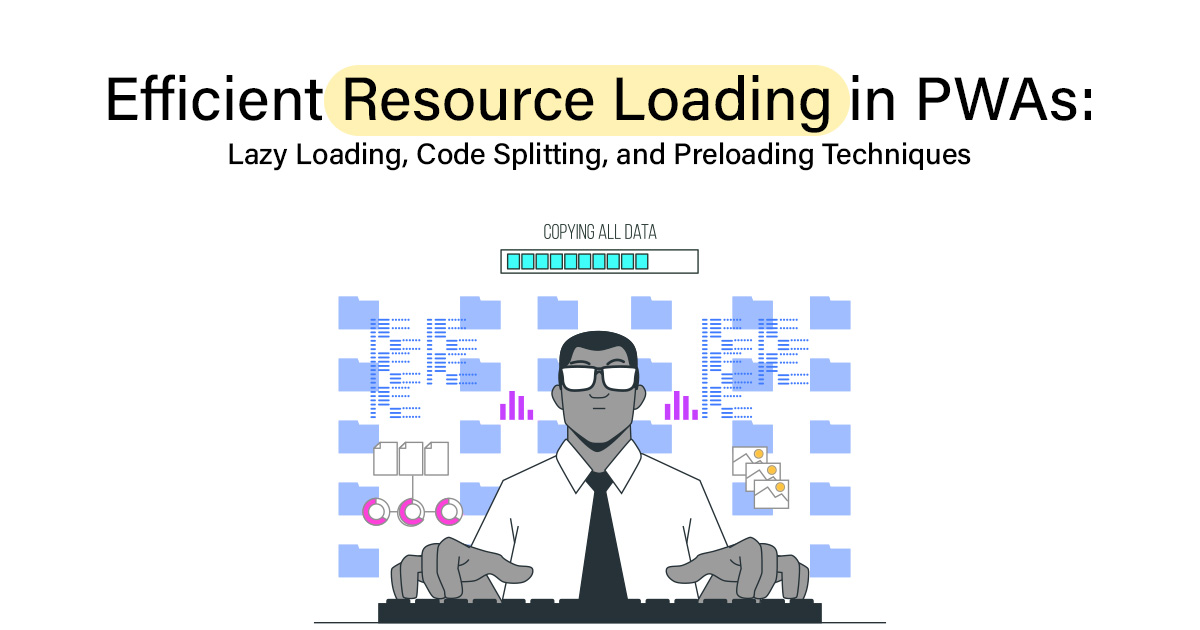



In the realm of Progressive Web Applications (PWAs), efficient resource loading plays a crucial role in enhancing user experience and optimizing performance. This article explores the techniques of lazy loading, code splitting, and preloading as effective strategies for achieving these goals.
By employing these methods, developers can efficiently load resources on demand, improve application responsiveness, and minimize initial load times. This article aims to provide valuable insights into the advantages, implementation approaches, best practices, and optimization strategies associated with these resource loading techniques in PWAs.
One advantage of lazy loading in progressive web applications (PWAs) is the ability to significantly reduce initial load times by only loading the necessary resources when they are actually needed. Lazy loading is a technique where resources such as images, scripts, and stylesheets are loaded on demand, rather than all at once during the initial page load.
Compared to eager loading, which loads all resources upfront regardless of whether they are immediately required or not, lazy loading offers several benefits. Firstly, it helps improve the overall performance of PWAs by reducing their initial load times. By only fetching and rendering essential resources initially, lazy loading allows users to access the core content quickly without waiting for unnecessary assets to download.
Additionally, lazy loading complements code splitting techniques in PWAs. Code splitting involves breaking down large JavaScript bundles into smaller chunks that can be loaded separately. When combined with lazy loading, code splitting allows for more efficient resource delivery as only the necessary parts of an application are downloaded when they are needed.
Moreover, lazy loading provides an optimized user experience by prioritizing critical content over non-essential elements. This ensures that users can interact with key features and functionality without any delays caused by unnecessary resource downloads.
Below is an example of how lazy loading can be used to load a module in a Progressive Web App:
// Before Lazy Loading
import HugeComponent from ‘./components/HugeComponent’;
// After Lazy Loading
const button = document.querySelector(‘#loadButton’);
button.addEventListener(‘click’, async () => {
const module = await import(‘./components/HugeComponent’);
const HugeComponent = module.default;
const instance = new HugeComponent();
instance.render();
});
Implementing code splitting in web applications can enhance performance by dividing the codebase into smaller, more manageable chunks that can be loaded on-demand. Code splitting is a technique used to optimize the loading and execution of JavaScript code in web applications. It involves breaking down the application’s source code into smaller modules, which are then loaded only when needed. This approach allows for lazy loading implementation, where modules are fetched and executed at runtime, reducing the initial load time and improving overall performance.
By implementing code splitting, developers can improve the performance of their web applications in several ways. Firstly, it allows for more efficient resource utilization by loading only the necessary modules when they are required. This reduces the amount of unnecessary code that needs to be downloaded and executed upfront, resulting in faster page loads and improved user experience.
Furthermore, code splitting enables parallel loading of multiple modules since they are divided into smaller chunks. This means that different parts of an application can be loaded simultaneously, taking advantage of the browser’s ability to handle multiple network requests concurrently. As a result, the overall loading time is reduced.
In addition to these benefits, code splitting also facilitates better caching strategies. Since each module is loaded separately and has its own unique identifier or hash value associated with it, updates or changes made to a specific module do not affect other parts of the application unnecessarily. This allows for more efficient use of caching mechanisms as only modified or new modules need to be reloaded.
Here’s an example of implementing code splitting using Webpack:
// webpack.config.js
module.exports = {
// …
optimization: {
splitChunks: {
chunks: ‘all’,
},
},
};
To enhance the performance of Progressive Web Applications (PWAs), developers can employ various methods to preload resources and improve overall user experience. Preloading resources in PWAs is crucial for optimizing resource delivery and minimizing loading times. By preloading commonly used assets, such as scripts, stylesheets, images, and fonts, developers can ensure that these resources are readily available when needed, reducing latency and improving perceived performance.
Here are four techniques for preloading resources in PWAs:
Illustrating how to use the rel=”preload” attribute in HTML:
<link rel=”preload” href=”styles.css” as=”style”>
<link rel=”preload” href=”main.js” as=”script”>
This discussion focuses on the best practices for efficient resource loading in Progressive Web Applications (PWAs).
Specifically, we will be looking at lazy loading benefits, code splitting techniques, and preloading optimization tips.
Lazy loading is a technique that helps improve performance by delaying the loading of non-essential resources until they are actually needed.
Code splitting involves breaking down a large JavaScript application into smaller chunks that can be loaded on demand, reducing initial load times.
Preloading optimization tips involve strategies to preload critical resources in advance to further enhance the speed and responsiveness of PWAs.
One advantage of lazy loading in PWA resource loading is the ability to improve initial page load times by deferring the loading of non-critical resources until they are actually needed. Lazy loading is a technique used in web development to optimize the loading process of a webpage. It differs from eager loading, which loads all resources upfront regardless of their immediate necessity.
Here are four benefits of lazy loading:
Code splitting is a technique used to optimize resource loading in Progressive Web Applications (PWAs). It involves breaking down the application’s codebase into smaller, more manageable chunks and only loading the necessary code when needed. By doing so, unnecessary code can be deferred, reducing the initial load time of the application and improving performance.
There are several code splitting techniques available for optimizing resource loading in PWAs. One approach is dynamic import, which allows modules to be loaded on-demand when a specific feature or functionality is required. Another technique is route-based splitting, where different parts of an application are split based on routes or user interactions.
To optimize the preloading process in web applications, developers can follow a set of recommended techniques. These techniques focus on improving preloading performance and ensuring efficient resource loading. Here are four key strategies for achieving optimal preloading:
Lazy loading in Progressive Web Applications (PWAs) is an effective technique for optimizing performance by deferring the loading of non-critical resources until they are needed. This approach contrasts with eager loading, where all resources are loaded upfront regardless of whether they will be used or not. By selectively loading resources on-demand, lazy loading reduces the initial load time and improves the overall user experience.
There are different implementation techniques for lazy loading in PWAs. One common approach is to split the application’s code into smaller modules or chunks and load them as needed. This technique, known as code splitting, allows developers to prioritize the critical components of their application and delay the retrieval of less essential ones. By doing so, unnecessary resources can be avoided during the initial page load, resulting in faster rendering times and improved perceived performance.
Another technique used for lazy loading in PWAs is dynamic imports. With this method, modules are imported only when necessary through a JavaScript function call. This enables developers to control when specific resources are loaded based on user interactions or other events within the application.
Implementing lazy loading requires careful consideration of resource dependencies and ensuring that critical functionality remains accessible at all times. Additionally, proper error handling should be implemented to handle cases where a resource fails to load correctly.
In contrast to eager loading strategies that prioritize immediate full-page rendering but suffer from longer initial load times due to unnecessary resource retrievals, lazy loading provides a more efficient way to optimize performance in PWAs. By deferring non-critical resource loads until they are actually needed, lazy loading reduces unnecessary overhead and delivers a smoother user experience.
An advanced approach using dynamic imports and async/await:
const button = document.querySelector(‘#loadButton’);
button.addEventListener(‘click’, async () => {
const [{ default: Component1 }, { default: Component2 }] = await Promise.all([
import(‘./components/Component1’),
import(‘./components/Component2’),
]);
const instance1 = new Component1();
const instance2 = new Component2();
instance1.render();
instance2.render();
});
One effective strategy for improving performance in Progressive Web Applications (PWAs) is the division of application components into smaller modules, allowing developers to prioritize critical elements and delay the retrieval of less important ones. This approach, known as code splitting, focuses on maximizing performance and optimizing loading speed by breaking down large chunks of code into smaller, more manageable pieces. By doing so, PWAs can load faster and provide a better user experience.
The benefits of code splitting in PWA development are numerous:
A more complex scenario with route-based code splitting:
// Using React Router
import { Route } from ‘react-router-dom’;
//…
<Route path=”/dashboard” component={lazy(() => import(‘./Dashboard’))} />
<Route path=”/profile” component={lazy(() => import(‘./Profile’))} />
Effective preloading strategies in Progressive Web Applications (PWAs) involve intelligently prioritizing the loading of critical resources to enhance performance and improve user experience. Preloading is a technique that allows developers to load resources before they are actually needed, reducing latency and improving overall page load times. By analyzing user behavior patterns and understanding which resources are essential for initial page rendering, developers can optimize preloading strategies.
One common preloading strategy is resource hints, which provide the browser with information about additional resources that will be needed in the future. These hints can be included in HTML headers or within the document itself using link tags. For example, the ‘preload’ attribute can be used to indicate that a specific resource should be loaded as soon as possible or during idle time.
Another effective approach is predictive preloading, where resources are loaded based on predictions made from historical data or machine learning algorithms. By analyzing user navigation patterns and predicting which pages users are likely to visit next, developers can preload resources in advance, further reducing perceived loading times.
Additionally, lazy loading techniques can also complement preloading strategies by deferring the loading of non-critical or below-the-fold content until it becomes visible to the user. This helps prioritize critical resources and improves overall performance.
To ensure optimal resource optimization through preloading strategies, it is important for developers to carefully consider which resources should be prioritized for preloading and constantly monitor and analyze their application’s performance metrics. By continuously refining their strategies based on real-time data insights, developers can achieve efficient resource loading in PWAs while enhancing user experience.
Demonstrating resource preloading based on user interactions:
document.querySelector(‘#productLink’).addEventListener(‘mouseenter’, () => {
const image = new Image();
image.src = ‘product-image.jpg’;
});
In conclusion, efficient resource loading is crucial for optimal performance in PWAs.
By implementing lazy loading, code splitting, and preloading techniques, developers can improve the user experience and minimize load times.
Lazy loading allows for on-demand loading of resources, while code splitting enhances performance by dividing the code into smaller chunks.
Additionally, preloading enables faster access to critical resources.
By following best practices and utilizing these techniques effectively, developers can maximize efficiency and optimize the performance of their PWAs.
OpenAI DevDay showcases the latest AI innovations, pushing technology’s boundaries in an ever-evolving landscape.
Explore the top 10 database types for software projects, their unique features, and which one…
Explore PWAs: Your FAQs Guide to Integrating Camera, Geolocation & Device APIs. Harness native features…
General Understanding of PWAs and SEO 1. What is a Progressive Web App (PWA)? A…
Understanding Offline-First Approach Basics 1. What is the concept of "Offline-First" in the context of…
General Overview 1. What are cross-platform frameworks, and how do they relate to Progressive Web…